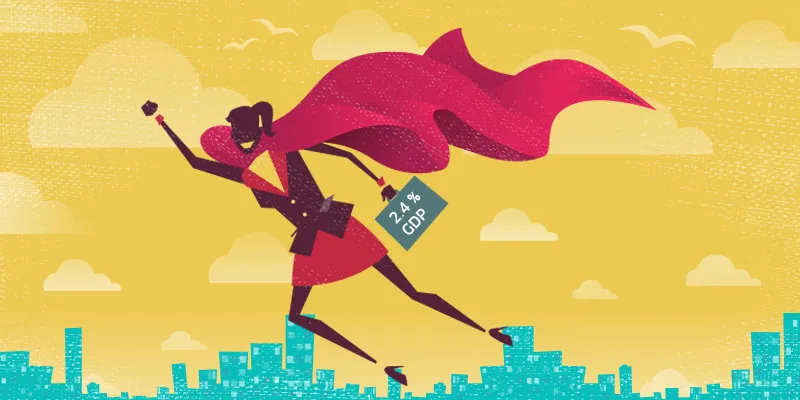How women power can add 2.4% to India’s GDP
Barring a few exceptions, women entrepreneurs in India are yet to be bracketed as role models and celebrities. But don’t be surprised if this changes fast. India is sitting at the cusp of a women entrepreneurship revolution. There is a growing list of trailblazers.
Rashmi Sinha, the founder of SlideShare which was acquired by LinkedIn in 2012, was named amongst the world’s Top 10 Women Influencers in Web 2.0 by Fast Company. Ashwini Ashokan, the founder of Mad Street Den that solves problems using artificial intelligence; Neeru Sharma, founder of online retailer Infibeam that has revenues running into millions; Anu Sridharan the founder of NextDrop that lets urban residents track availability of piped water; Sheetal Walsh whose Shanti Life provides microfinance to slum dwellers to start businesses and Sairee Chahal, founder of Sheroes that connects talented women professionals to career opportunities. The list is ever growing and strengthening the perception that in times to come women entrepreneurs will hold tremendous influence on India’s economy.

The trend of women taking to entrepreneurship has grown silently. But historically speaking, this is a most natural trend in India where women were well known to roll out ‘papads’ and pickles – and as far back as 1959 the iconic ‘Lijjat Papad’, an Indian women’s cooperative, was born. Today it employs 42,000 people and has a turnover of over Rs. 800 crore! With a legacy like that can Indian women not be at the forefront of entrepreneurship?
According to a 2015 report released by BNP Paribas covering US, Europe, Middle East and Asia, India ranks as the most active country for successful women entrepreneurs. The report finds that an astonishing 49% of entrepreneurs in the country are women and places India ahead of Hong Kong and France, the other two nations that follow India in terms of active women entrepreneurs.
The trend is giving rise to multiple support systems and accelerators aimed at promoting and sustaining women entrepreneurs. In March 2014, NASSCOM launched Girls in Technology (GIT), a programme to ensure that women find it easier to set up internet based technology companies. Recently FICCI launched ‘Swayam’ in Ahmedabad with the aim of supporting women entrepreneurs. HSBC India chairman, Naina Lal Kidwai, befittingly chaired this event. These are just two examples of a healthy and vibrant ecosystem that is fast falling in place to incubate and support women entrepreneurs in India.
Education and vocational training are the primary drivers for turning the entrepreneurial aspirations of women into reality. But there are other socio-economic reasons for driving the transition of more and more women starting businesses as diverse as pet care clinics, loan recovery firms, presentation-sharing platforms, wheelchair manufacturing, telemarketing companies, herbal care products, publishing, public relations organizations and learning management systems. Traditional family structures are changing that are allowing women an independent voice; the gender gap between men and women has narrowed, enabling women to find their feet and unlock their potential; they are acquiring the confidence and self-belief required for being a true entrepreneur; and they are able to network and find funding and mentoring more easily than ever before.
At the bottom of this trend are government schemes and policies that support and encourage women entrepreneurship, making it easier for them to develop entrepreneurial skills (through skills development programmes) and find institutional finance, infrastructure and talent. As examples, we have the Trade Related Entrepreneurship Assistance and Development (TREAD) Scheme provided by the Ministry of Micro, Small & Medium Enterprises (MSME). TREAD provides subsidy of up to 30% of project cost and the balance 70% as loan to women entrepreneurs. Additionally, there are innumerable schemes launched by banks aimed at women entrepreneurs. In fact, the Bharatiya Mahila Bank, which opened in 2013, and run by Usha Ananthasubramanian — another role model for women in India — focuses on urban and rural unbanked women and helps them establish their businesses.
The Organization for Economic Co-operation and Development (OECD) reports that the annual growth of the economy could improve 2.4% if India implements pro-growth and pro-gender policies. To truly leverage this trend, India must ensure that women have easier access to education and training, to workshops that address the development of skills such as accounting, marketing, human resource management and production. It is important that women have easier access to trade fairs and conferences in India and abroad, so that they meet others like themselves and interact with buyers in larger markets. And above all, it is imperative that a National Grievances’ Forum is set up where the problems that women entrepreneurs face in day-to-day work environments are quickly addressed.
Women entrepreneurs are a precious resource and the trend of growing entrepreneurship among women is most welcome. Women are strong, patient, competitive, resourceful and nurturing by nature. They have the ability to bring innovation and new perspectives to running business – attributes that modern businesses management theories have come to recognize as critical for success. According to World Economic Forum’s (WEF) Global Gender Gap Report 2014, India’s women make up slightly over a third of the workforce and hence their increased contribution to GDP and the ability to create employment could be a game changer for India’s economy.
About the Author: Atul Raja is Executive Vice President-Marketing, Wadhwani Foundation
(Disclaimer: The views and opinions expressed in this article are those of the author and do not necessarily reflect the views of YourStory)







